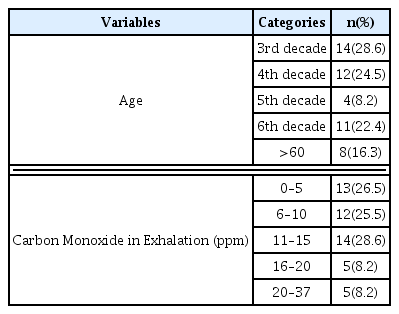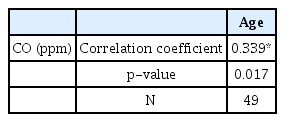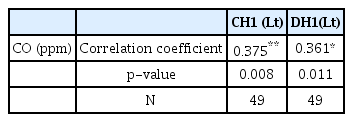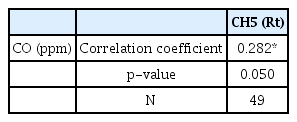References
1. David MB, Kasper DL, Braunwald E, Fauci A, Hauser S, Longo D, Jameson JL, eds. Harrison’s principles of internal medicine 15th edth ed. Columbus: McGrawHill; 2001. p. 2574–7.
2. Who Expert Committee. Smoking control strategies in developing contries Geneva: World Health Organization; 1983.
3. Choi HL. Smoking Cessation Program. Kor J of Family Medicine 1993;14(6):396–405.
4. US Department of Helath and Human Service (USDHHS). The Health Consequences of Smoking. A Report of the Surgeon Genaral Rockvile (MD): 2004.
5. Song HL, Kim CH. Epidemiology of Smoking-Related Diseases in Korea. Kor J of Family Medicine 2008;29:563–71.
6. Jung HS, Kim MJ, Kim HC. Recognition of Osteoporosis in ancient Chinese literature. J Kor Medical Classics 2011;24(6):125–30.
7. Kim IS. Smoking and Health. J Kor Med Sci 1987;30(8):825–30.
9. West FS, Todd WR. Textbook of biochemistry New York: The Macmillan Company; 1962.
10. Kim YS. Indoor environmental science Seoul: Min-eumsa; 1995. p. 157–8.
p. 545.
11. Lim BK, Kim SW, Kang JH, Yang YJ. Smoking status and expired carbon monoxide concentration. Kor J Family Med 2001;22(5):674–82.
12. Jarvis MJ, Russell MA, Saloojee Y. Expired aircarbon monoxide: a simple breath test of tobacco smoke intake. British Med J 1980;281:484–85.
13. Becona E, Vazquez FL. Self-reported smoking and measurement of expired air carbon monoxide in aclinical treatment. Psychological Reports 1998;83:316–18.
14. Benowitz NL. The use of biologic fluid samples in assessing tobacco smoke consumption. National Institute of Drug Abuse 1983;:6–26.
15. Lerman C, Orleans CT, Engstrom PF. Biological markers in smoking cessation treatment. Seminar in Oncology 1993;20:359–67.
16. Park YB. The Principle of Yangdorak and Its Clinical Utilization. Third medicine 1996;1(2):83–94.
17. Jang GS, Na CS, So CH. Measurement of Qi Induced by the Needle Insertion on LI4, LI11 Accupoint using the Oriental Medicine Instruments. Integr Med Res 1995;1(1):159–78.
18. Oh SJ, Park YJ, Park YB. Studies on thecharacteristics of the Yin-Yang, Heat-Cold by the Yangdorak patterns. J Kor Instit Orient Med Diagnosis 2003;8(1):86–108.
19. Bang JK, Park YC, Lee SH, Chang DI, Lee YH. The study on the characteristics of Yangdorak in the patients with idiopathic parkinson’s disease. J of Kor Acupuncture 2006;23(6):153–64.
20. Hwang JH, Jung SY, Jung SK. The diagnostic values of Ryodoraku and pulse analysis for respiratory disease patients. Kor J Orient Int Med 2007;28(3):560–9.
21. Kim ES, Lee JM, Lee CH, Cho JH, Jang JB, Lee KS. A study on characters of Yangdorak in climacteric women. J Orient Obstet Gynecol 2008;21(4):159–68.
22. Kim KS, Chung SH, Kim SS, Lee JS. The study on the characteristics of Ryodoraku score in the chronic low back pain patients. J Korean Med Rehab 2009;19(1):145–54.
23. Kim WH, Kim JW. A study on Bian Zhenganalysis of Bi Wi disease patient by Yangdorak diagnosis system. J Dong-Eui Orient Med 2000;33:127–46.
24. Moon YH, Bae HS, Moon SK, Ko CN, Kim YS, Cho KH. Clinical investigation about the interrelationship between differentiation of syndroms and numerical value of measurement (Yang-do-rack diagnosis) in acute stroke patients. Korean J Orient Int Med 1998;19(2):28–36.
25. Oh MJ, Shim YS, Song HS. Sasang constitutional diagnosis by portable Ryodoraku device:comparative study with QSCC II questionnaire. J of Kor Acupuncture 2013;30(4):161–7.
26. Lee CH, Lee GY, Song BG. A Study on Yangdorak Changes in Pregnant Women More than 30 Weeks Pregnant. Kor J of Oriental Gynecology 1999;12(1):14–21.
27. Gellert C, Schottker B, Brenner H. Smoking and all-cause mortality in older people: systematic review and metaanalysis. Arch Intern Med 2012;172:837–44.
29. Kim IS. Did you know? Toxification of tobacco Seoul: Korea Non-smoking Council; 1991.
30. Kim IS. Smoking and health. Korean Medical Association 1989;30:8.
31. Vogt TM, Selvin S, Widdowson G, Hulley SB. Expired air carbon monoxide and serum thiocyanate as objective measures of cigarette exposure. Am J Public Health 1977;67:545–9.
32. Vesey CJ, Saloojee Y, Cole PV, Russel MAH. Carboxyhemoglobin, Plasma thiocyanate and cigarette consumption : Implication for epidemiological studies in smokers. Br Med J 1982;284
33. Saloojee Y, Vesey CJ, Cole PV, Russel MAH. Carboxyhemoglobin, plasma thiocyanate : Complementary indicators of smoking behavior. Thorax 1982;37:521–5.
34. Jarvis MJ, Phil M, Tunstall-Pedoe H, Feyerabend C, Vedey C, Saloojee Y. Comparison of tests used to distinguish smokers from nonsmoker. Am J Public Health 1987;77(11):1435–8.
35. Wildox RG, Hughes J, Roland J. Verification of smoking history using history using urinary nicotine and cotinine measurements. Br Med J 1979;2:1026–8.
36. Harley NJ, Axelrad MS, Tilton BS. Validation of self-reported smoking behavior : Biochemical analysis of cotinine and thiocyanate. Am J Public Health 1983;73:1204–7.
37. Hughes JR, Frederiksen LW, Frazier MA. Carbon monoxide analyzer for measurement of smoking behavior. Behavior Therapy 1978;9:293–6.
38. Jarvis MJ, Russell MAH, Saloojee Y. Expired air carbon monoside : simple breath test of tobacco smoke intake. Br Med J 1980;281:484–5.
39. Jarvis MJ, Belcher M, Vesey C. Low cost carbon monoxide monitor in smoking assessment. Thorax 1986;41:886–7.
40. Wald NJ, Idle M, Boreham J. Carbon monoxide in breath in relation to smoking and carboxyhemoglobin level. Thorax 1981;36:366–9.
41. Jee SH, Yun JE, Park JY, Sul JW, Kim IS. Smoking and cause of death in Korea: 11 years follow-up prospective study. Korean J Epidemiol 2005;27:182–90.
42. Bae J, Gwack J, Park SK, Shin HR, Chang SH, Yoo KY. Cigarette smoking, alcohol consumption, tuberculosis and risk of lung cancer: the Kor multi-center cancer cohort study. J Prev Med Public Health 2007;40(4):321–8.
43. Bae JM, Lee MS, Shin MH, Kim DH, Li ZM, Ahn YO. Cigarette smoking and risk of lung cancer in Korean men: the seoul male cancer cohort study. J Kor Med Sci 2007;22:508–12.
44. Jee SH, Park J, Jo I, Lee J, Yun S, Yun JE. Smoking and atherosclerotic cardiovascular disease in women with lower levels of serum cholesterol. Atherosclerosis 2007;190:306–12.
45. Khang YH, Lynch JW, Jung-Choi K, Cho HJ. Explanining age-specific inequalities in mortality from all causes, cardiovascular disease and ischemic heart disease among South Korean male public servants: relative and absolute perspectives. Heart 2008;94:75–82.
46. Oh SJ, Park YJ, Park YB. Studies on thecharacteristics of the Yin-Yang, Heat-Cold bythe Yangdorak patterns. J Korea Instit Orient Med Diagn 2003;8(1):86–108.
47. Park YB. The Principle of Yangdorak and Its Clinical Utilization. Third medicine 1996;1(2):83–94.
48. Kyunghee University School of Oriental Medicine 45th Graduation Preparation Committee. Practical approach to diagnosis of oriental medicine Seoul: Iljungsa; 1997. 202-4p. 213–25.
49. Wen Su, ; the Integrated Research Publication Committee. Su Wen research integration Daegu: Venus Printer; 2001. p. 297.
50. Ling Shu Research integrated publication committee. Ling Shu Research integration Daegu: Cheongwoon Printing; 2006. p. 346–50.
51. Kim JC, Zo EH, Bang JK. Study on Jinsatak (陳士鐸)’s theory of Simpo(心包) J. Oriental Medical Classics 2010;23(2):141–55.
52. Baik ES, Kim HI, Kim JH, Yoon EK, Kim SH, Park CH. A Study on the Relation of Pathologic Mechanisms of Samcho in Hwangdineijing and Samcho-Sanghwa. J Korean Medical Classics 2016;29(2):187–202.







